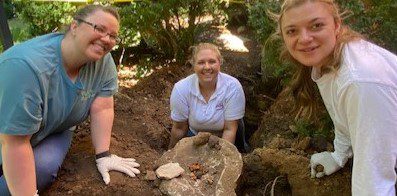Article by Elizabeth Abram, Graduate Intern at the Heritage Foundation of Williamson County

HF interns Elizabeth Abram, Alexandra Hasty, and Chase Collyer-McLaughlin assisting with recovery archaeology at Franklin Grove (Sept. 2022)
We’ve all heard the proverb: One man’s trash is another man’s treasure. But it wasn’t until I started volunteering with the Heritage Foundation of Williamson County that the well-known idiom took on real meaning.
As part of my internship with the Heritage Foundation I am assisting with archaeology at Franklin Grove Estate & Gardens. Rachael Finch, the Senior Director of Preservation and Education had me “dig” into the project by literally putting my hands in the dirt. For my inaugural assignment, I, along with three other graduate interns, became tasked to sift through several excavated areas, recently cleared away from one of the historic houses on the property. The mounds were a result of a visual foundation and structural inspection completed at an earlier date.
Salvage Archaeology
“This,” Rachael said pointing to one of the excavated areas, “is considered salvage archaeology.” Salvage archaeology, my dear readers, is when an archaeological site has already been unwittingly damaged through construction, or some other form of ground disturbance. Rather, for our purposes, “salvage” may be too strong of a word; Instead, Rachael asked us to consider “salvage archaeology” not as off-putting terminology, but for us to experience – hands-on – how our work is recovering archaeology. Recovering also means discovering – bring the past to light. And we are discovering more about the history of Franklin Grove each day as we work to rehabilitate a historic gem in downtown Franklin.
At first sight, these two mounds appeared to be nothing more than the byproduct of a required structural inspection job, but as the five of us scraped the soil away, literally digging into the dirt pile, we unearthed many items—historical treasures.
It turns out, the debris piles were full of clues to the stories of the people who once lived on the property. During our time, we uncovered items such as: nails, chipped paint flecks, shards of window glass, pieces of broken dinnerware, a piece of a glass pitcher, coins, and charred bricks. All are objects of the past and represent the people – Black, white, and Native American – who once lived, worked, or hunted the grounds we now know as Franklin Grove Estate & Gardens.
We were pleased with our findings. They were historical treasures indeed, but their historic significance is yet to be determined. We are currently in the process of cataloging each artifact to preserve them. Proper curation allows these treasures to be used by future researchers.
The Definition of a “Treasure”
What makes something worthy of the label—treasure? Does it have to meet a predefined price threshold? Or is it based on the item’s uniqueness or age? The definition of a treasure is far less rigid than the pirate-adventure stories of my youth had led me to believe. A treasure, despite its monetary worth or beauty, is anything we give value to.
Our small group of researchers valued the pieces we’d pulled from the ground. So, treasure is very much an appropriate word for our findings. However, I have also learned that something being old isn’t enough to make it historically significant. I’m sure you are on the edge of your seat with bated breath, eager to know the answer to the question: Are the pieces we found at Franklin Grove historically significant? And the answer is –We don’t know yet, but their value demands that we find out. (This will happen in an upcoming blog post!)
Humans are naturally curious creatures. This is proven by the popularity of paparazzi photos and headlines about how Celebrities are just like us: they run errands, walk their dogs, drop their kids off at school, and go out to eat with friends. We give ordinary pictures and signatures (autographs) value because we believe it gives us insight into a famous person’s life.
The artifacts unearthed at Franklin Grove get their value in a similar way. A nail is a remnant of a porch that once existed on the front of the Perkins-Winstead mansion, paint flecks show us that the shutter colors changed with the fashions and current trends of the time, shards of window glass may have been broken during a house fire that damaged part of the home during the Civil War, pieces of dinnerware—possibly an heirloom—with its own family history and meaning, and a coin that may have fallen from a civil war soldier’s pouch.
Value Comes From Insights
The value of these artifacts isn’t measured in terms of monetary worth; no, the value comes from the insight it provides us of into the lives of a generation long gone. The value comes from seeing with our own eyes that people at their core haven’t changed. Yes, our clothes have gotten tighter, our hairstyles are shorter, and our makeup less poisonous, but our humanness remains unchanged.
People of the past are just like us: they maintained their houses, struggled with unexpected turmoil, and lived their lives the best way they knew how. We admire their normalness and find validation that at our core—we’re doing okay. We’re living our lives, making memories, and looking for our own treasures in life. Carry on!